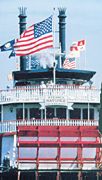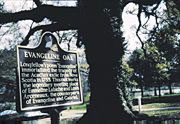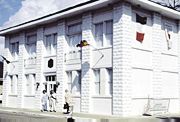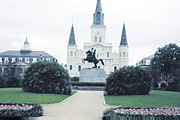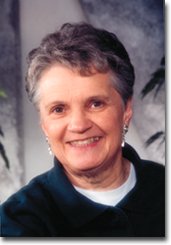
| Louisiana |
Imagine if you will, another place and another time. The French and English are at war. The British are fearful of the Acadians loyalty to France. The men are called to a fictitious meeting and held prisoners. Women and children are loaded into boats according to their ages so families were separated, in some cases, forever. The men were deported later.
After years of suffering in their search for acceptance, many responded to an invitation by the King of Spain in 1784, to settle in South Louisiana. Happy in their new location, the news spread quickly to the scattered remnant, to join their ranks. Longfellow's poem Evangeline was published in 1847, introducing the story of the Expulsion to the English speaking world.
This tragic but fictional account of Evangeline and Gabriel, separated on their wedding day, made Grand Pre, Nova Scotia a place of special interest. A huge stone cross marks the cemetery, a lovely statue of Evangeline and a Memorial Church/Museum are part of Grand Pre National Historic Site. Guides dressed in period clothing reenact history.
In Louisiana, Lafayette is the unofficial capital of Cajun Country and Acadian Village, a living museum helps to preserve the language, lifestyle and early structures of Acadian life. A blacksmith shop, doctor's office, a quaint little chapel and a 400-year-old dugout canoe are part of the village which is a blaze of colour with pink, purple and white azaleas and fragrant magnolias.
The men of Louisiana love to cook! A group of retired men called the "Bubbas" prepare the food because they want strangers to experience southern hospitality and cuisine at its best. They served crawfish etouffee, alligator sauce piquante, jambalaya (shrimp stew served over rice), fried turkey, fried alligator, curl fried potatoes and seafood gumbo (a thick shrimp soup served over rice). The announcement was made, "Anything ya'all need, jest call me."

Vermilionville is a performance center in Lafayette that represents Cajun life in early Louisiana. Performers entertain with authentic music and dancing. In the surrounding village, volunteers dressed in period attire demonstrate the trades of the day — woodworking, blacksmithing, spinning, weaving and sewing.
The Jean Lafitte Acadian Culture Center presents a video donated by the Canadian Government, telling the story of the Deportation from the brutal round-up, to the humiliation and degradation of a proud people as they were shipped off to the southern states, England, France and the Caribbean.
Huge cypress trees represent a forest 200 years old. Signs posted "Don't Enter Feb-July - Birds Nesting." We saw turtles basking in the sun, water mocassins, alligators, nutria (like a ground hog), owls, egrets, ibis, osprey, bald eagles, night herons and anhinga. This is also a nesting ground for Roseat Spoonbills, huge white birds with pink wing tips and undersides. Watching them fly is a beautiful sight.
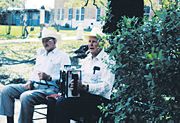
The French Quarter is the city's prime tourist attraction. It is an area bordered by Canal Street, Esplanade Avenue, Rampart Street and the Mississippi River. The center is Jackson Square named in honor of General Andrew Jackson, the hero of the Battle of New Orleans. The Cabildo and Presbytere flank St. Louis Cathedral. The Cabildo was the seat of Spanish colonial rule and the site of the Louisiana Purchase transfer in 1803. Now a museum, the memorabilia of 200 years of history are on display. The Presbytere, originally the residence of the Capuchin monks of St. Louis Cathedral exhibit s Mardi Gras: It's Carnival Time in Louisiana - the interesting evolution of Carnival.
Music everywhere! A jazz band was brightening everyone's day but some local children were doing a neat tap routine and a small marching band made up of young children, was gathering a little crowd of its own. What a happy atmosphere!
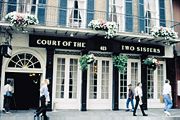
The French Market is the country's oldest public market with five blocks of retail and specialty shops, entertainment, the Farmers Market and Community Flea Market on the Mississippi River. The shopping was so much fun I had to buy a suit case to get back to the motel. To top it off I bought a dozen pralines from Aunt Sally's Praline Shop.
My next two nights were spent at Maison St. Charles Quality Inn and the St. Charles Streetcar stopped right across the street. This is a fun route, 13.2 miles on an oak lined avenue past the antebellum and Victorian mansions of "Uptown" New Orleans. Stop at #14 for the Garden District. A true bargain at $1 one-way.
The Riverfront Streetcar follows the Mississippi on a 1.9 mile route from Esplanade to the Convention Center,with stops at the Aquarium of the Americas and Riverwalk - an upscale shopping mall with 140 shops.
